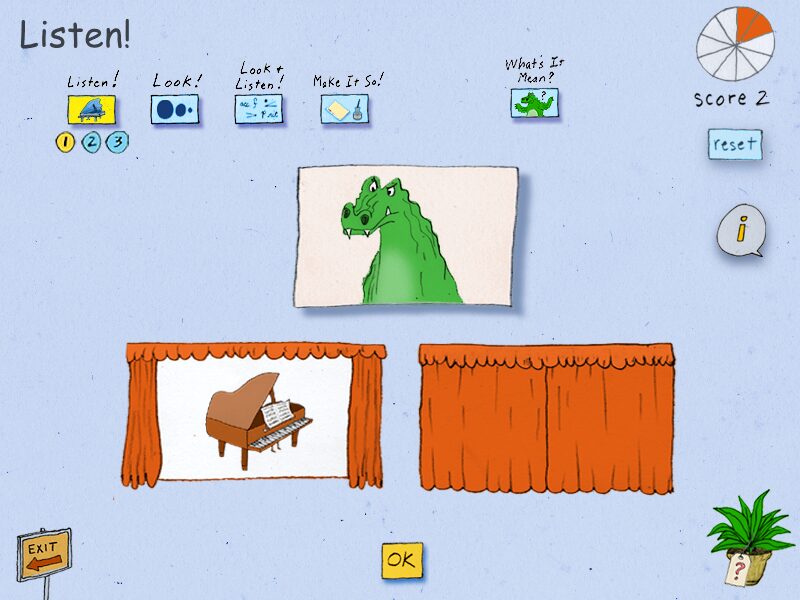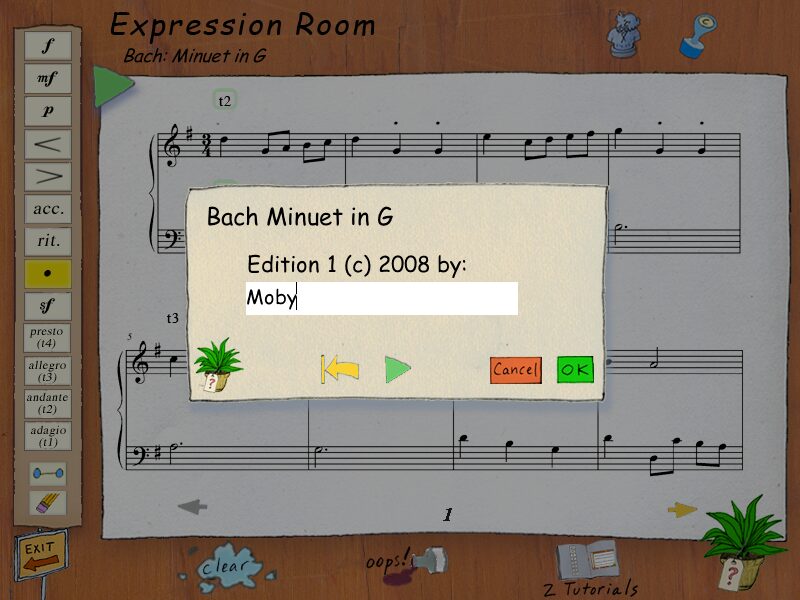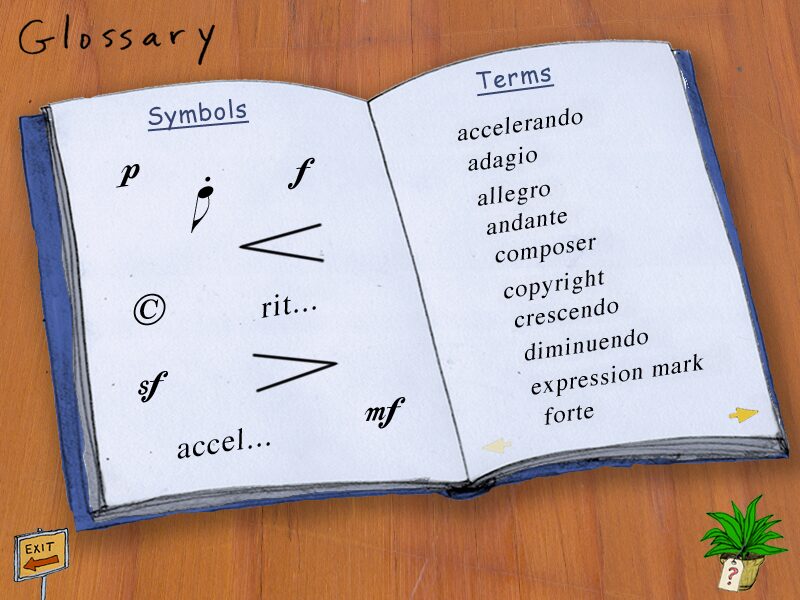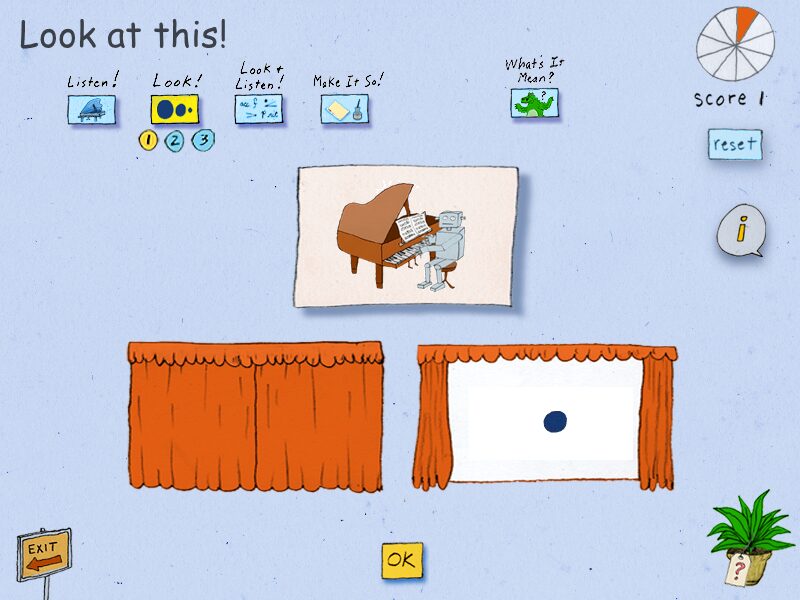Retro Replay Review
Gameplay
Morton Subotnick’s Playing Music delivers a thoughtful blend of listening exercises, visual puzzles, and creative composition tools that guide children through the fundamentals of music. The point-and-click interface is intuitive, allowing young users to navigate effortlessly among the five distinct mini-games. Each activity reinforces the “Listen, Look and Make It So” philosophy by requiring kids to engage with sound, interpret visual cues, and produce their own musical ideas.
The first game challenges players to listen to a short musical excerpt presented in two different styles—perhaps legato versus staccato or loud versus soft—and decide which rendition matches given criteria. In the second exercise, learners hear a melody and match it to animated images, such as a bouncing ball mirroring rhythmic patterns. Subsequent activities include identifying missing notes on a musical staff, distinguishing melodic motifs, and arranging snippets into coherent musical phrases.
Beyond passive listening, Playing Music invites children to become composers. The built-in composition studio offers simple drag-and-drop notation tools, an on-stage auditorium view for performance, and an audience perspective for critical listening. Users can even “copyright” their original pieces, store them in a virtual library, and receive feedback from playful in-game characters who comment on expressiveness, structure, and originality.
Graphics
Visually, Playing Music strikes a balance between colorful whimsy and clear instructional design. The main menus and game screens feature bright, child-friendly palettes that keep users engaged without overwhelming their senses. Icons for notes, symbols, and instruments are oversized and well-labeled, ensuring that even novice readers can grasp each concept.
Animations—like the bouncing ball in the image-matching game—are smooth and responsive, reinforcing the auditory lessons with synchronized visual feedback. Transitions between video demonstrations and interactive panels are seamless, maintaining a steady learning pace. Character avatars for critics and guides are charmingly drawn, each with distinct expressions to match their in-game personalities.
When working in the composition studio, musical staves and symbols are rendered crisply, with adjustable zoom and snap-to-grid features that help young composers place notes accurately. The auditorium stage uses dynamic lighting effects to simulate a live performance, while the audience view employs subtle depth cues to make listening feel immersive. Overall, the graphical presentation is both pedagogically sound and aesthetically pleasing.
Story
Although Playing Music isn’t a narrative-driven adventure, it frames the educational journey as a musical rite of passage. Children begin as curious listeners, progress to keen analysts, and ultimately step into the role of composer. This implicit storyline of growth and discovery gives purpose to each exercise and fosters a sense of accomplishment at every stage.
Guiding this journey are a cast of in-game characters—an encouraging conductor, a critical critic, and a supportive audience member—who address players by name, offer tips, and celebrate musical breakthroughs. Their playful banter and tailored feedback create a lightly scripted narrative that keeps users motivated and invested in the learning process.
The progression from simple recognition tasks to open-ended composition unfolds like chapters in a book: listeners evolve into interpreters, interpreters evolve into creators. By the time children finish all five games, they’ve experienced a coherent “story” of musical mastery that goes beyond drills—transforming abstract notes into personal expression.
Overall Experience
Morton Subotnick’s Playing Music excels as a comprehensive educational tool that doubles as an entertaining game. The modular structure lets parents and teachers tailor lessons to each child’s pace, while the reward system—unlocking new instruments, earning positive critiques, and compiling an original repertoire—drives continued engagement. With over 20 works by famous composers included, users gain exposure to classical and contemporary styles alike.
The user interface is welcoming and accessible, requiring minimal reading skills and no prior musical knowledge. The “Listen, Look and Make It So” methodology ensures that children build auditory discrimination, visual literacy, and creative confidence simultaneously. Built-in glossaries of musical terms and symbols reinforce learning, making the program a reference as well as an interactive tutor.
Ultimately, Playing Music offers a rich, replayable experience that nurtures budding musicians. By blending high-quality audio examples, responsive visuals, and open-ended composition tools, the game transforms abstract musical concepts into hands-on discovery. For parents seeking an engaging introduction to music theory or for classrooms aiming to spark creative expression, this title is a compelling investment in a child’s artistic development.
 Retro Replay Retro Replay gaming reviews, news, emulation, geek stuff and more!
Retro Replay Retro Replay gaming reviews, news, emulation, geek stuff and more!









Reviews
There are no reviews yet.